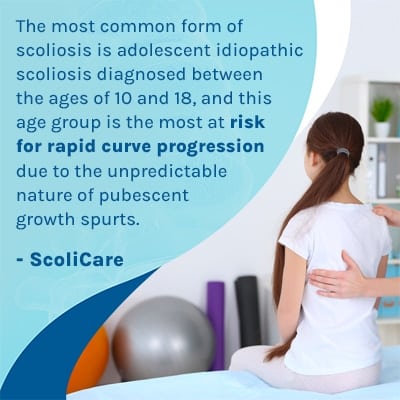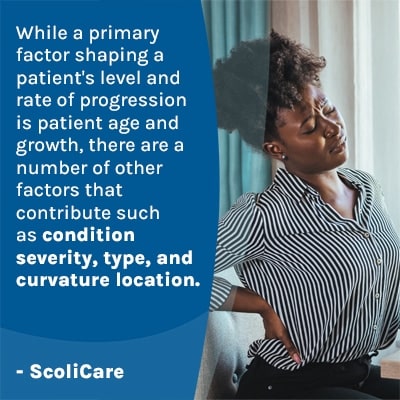As a progressive condition, the nature of scoliosis is to become more severe over time and with growth, but rates and levels of progression can range widely from patient to patient. It’s important to understand that scoliosis treatment involves addressing an ongoing spinal condition.
As a progressive condition, scoliosis won’t simply go away or improve on its own, and while progression tends to slow once skeletal maturity is reached, scoliosis can still progress in adulthood. Once age-related spinal degeneration becomes a factor, adult scoliosis can progress quickly.
A patient’s potential rate of progression is shaped by a number of factors, the most important of which is patient age.
Patient Age and Progression
Most people consider scoliosis a childhood condition, and this is because it’s most often diagnosed during childhood, but scoliosis affects all ages (1, 2).
 The most common form of scoliosis is adolescent idiopathic scoliosis diagnosed between the ages of 10 and 18, and this age group is the most at risk for rapid curve progression due to the unpredictable nature of pubescent growth spurts (1, 2).
The most common form of scoliosis is adolescent idiopathic scoliosis diagnosed between the ages of 10 and 18, and this age group is the most at risk for rapid curve progression due to the unpredictable nature of pubescent growth spurts (1, 2).
We don’t know why most cases of scoliosis develop, but we do know it’s growth that triggers progression, and we do know how to respond with treatment.
Growth and Progression Risk
So adolescent scoliosis carries a high risk of rapid progression, and the progressive line of scoliosis is mild scoliosis to moderate scoliosis and severe scoliosis.
So if growth is triggering progression, the size and rotation of the unnatural lateral curvature of the spine will increase, causing more noticeable symptoms to develop, and making the scoliosis more complex to treat.
While age and bone maturity is an important factor that determines a patient’s potential rate of progression, gender is an additional risk factor for progression; in fact, adolescent females are 10 times more likely to experience progression requiring intervention, but it’s important to understand that all levels of scoliosis, even mild cases, can benefit from intervention in the form of a proactive treatment plan (1, 2).
The idiopathic designation means cause unknown, so it’s not clear why females with adolescent scoliosis are more prone to progression than males of the same age, but a common theory attributes the earlier start of puberty in females.
There are no treatment guarantees, but in most cases, the sooner treatment is started, the better because mild scoliosis is simpler to treat than moderate and severe cases, and although progressive, scoliosis can be highly treatable (2).
So as growth triggers progression, the more growth a patient has yet to go through indicates more potential progression, which is why childhood scoliosis should always be taken seriously and treated proactively.
As we’ve addressed progression in the condition’s most-prevalent type and age group affected, let’s talk about progression of adult scoliosis (3).
Progression and Adult Scoliosis
The topic of scoliosis progression can be an interesting one.
If growth triggers progression, once skeletal maturity is reached, does this mean progression stops when growth stops? This can seem like a logical assumption, and for many years, this was the consensus, but through observation and research, we now know this is not the case (3).
While adult scoliosis progression tends to slow once growth has stopped, it’s important to understand that scoliosis isn’t a static condition; it’s always changing, and as the spine’s health changes over time, progressive rates of adult scoliosis can change in response (4).
Progression of Adolescent Scoliosis in Adults
The most common type of scoliosis to affect adults is idiopathic scoliosis known as adolescent scoliosis in adults (ASA), and this type highlights the importance of early diagnosis and intervention because many of these cases are pre-existing.
The first step to assessing adult scoliosis is determining whether the scoliosis is pre-existing or developed fresh in adulthood with no prior history as degenerative de-novo scoliosis (4).
If adolescent scoliosis is left undiagnosed and untreated, it doesn’t just go away, even if it’s not causing noticeable enough symptoms to lead to a diagnosis.
There is another important factor that can make early detection of childhood scoliosis challenging: pain (1).
Scoliosis in children doesn’t always come with pain, but it is often the main symptom adult patients experience (5).
While idiopathic scoliosis progression can slow once growth has stopped, this is also when scoliosis commonly becomes painful.
Progression of Adult De-Novo Degenerative Scoliosis
The next most-common type to affect adults, adult de-novo degenerative scoliosis, can progress quickly due to the spine experiencing degenerative changes (3).
Most spinal degeneration starts with the intervertebral discs; as they deteriorate, they change shape and affect the position of vertebrae as adjacent vertebral bodies attach to the disc in between.
Virtually all cases of degenerative scoliosis are going to be progressive and painful as the spine becomes increasingly unbalanced and unstable, and the level of movement within the spine can put adults at risk of injury through a fall.
While a primary factor shaping a patient’s level and rate of progression is patient age and growth, there are a number of other factors that contribute such as condition severity, type, and curvature location.
Additional Fac tors That Shape Progression
tors That Shape Progression
Part of the reason scoliosis is so often deemed a complex condition to treat is because there are so many changing factors involved.
Not only does growth trigger progression, condition severity also plays a role; the more severe cases are, the more likely it is that progression will not slow/stop on its own.
Scoliosis Type and Severity
Condition type is also important and is determined by causation. Again, the most common type of scoliosis is idiopathic, and these cases involve typical right-bending curves, but there are additional types associated with known causes that can involve particularly severe left-bending curves: neuromuscular scoliosis, degenerative scoliosis, and congenital scoliosis.
Atypical condition types can be severe and progress quickly; neuromuscular scoliosis, for example, is caused by the presence of a larger neuromuscular condition and can advance rapidly.
However, this level of progression is more due to the larger neuromuscular condition disrupting communication between the brain, the spine, and muscles/connective tissues that support and stabilize the spine, than the scoliosis itself.
Curve progression can also be shaped by the location of the scoliosis within the spine.
The three main sections of the spine include the cervical spine (neck), thoracic spine (middle/upper back), and the lumbar spine (lower back) (1).
Although scoliosis can develop in any spinal section or in more than one as a combined scoliosis, the thoracic spine is the largest section and the most commonly affected; single thoracic curves are more prone to rapid progression.
If a condition is left untreated, or not treated proactively, this can also shape progression because nothing, or little, is being done to proactively work toward preventing progression, which in many cases is very possible.
Conclusion
So there is no clear answer to the question of what age scoliosis stops progressing because the very nature of a progressive condition is to be ongoing, but this doesn’t mean progression can’t be effectively managed with treatment.
The most important thing to understand about scoliosis is that as a progressive condition, it’s always changing, and a benefit of customizing treatment allows for disciplines to be apportioned accordingly, and adjusted, based on how a spine responds to growth and/or treatment.
The more growth a patient has to go through prior to reaching skeletal maturity can indicate their progression risk, but there are also other factors that play a role such as condition severity, type, and curvature location.
Part of a patient’s initial assessment involves determining progression risk, and the more accurate and comprehensive an initial assessment is, the more customized treatment plans can be, and the more specific potential results can be.
As a leader in nonsurgical scoliosis treatment, ScoliCare Clinicians assess scoliosis patients comprehensively to ensure they can be paired with the best treatment plan and provider.
The best way to treat scoliosis is proactively; adolescents facing the risk of rapid-phase progression can benefit from proactive treatment that focuses on counteracting the progressive nature of scoliosis, despite the constant trigger of growth occurring in young patients.
While adults don’t typically progress as rapidly as children, scoliosis can still progress into adulthood, and if spinal degeneration is occurring, older adults are particularly at risk of rapid progression and increasing instability in the spine and body.
So while patient age, gender, severity, type, and curvature location can shape a patient’s level and rate of progression, a proactive and customized nonsurgical treatment plan will take each of these risk factors into account.
References:
- Weinstein SL. The Natural History of Adolescent Idiopathic Scoliosis. J Pediatr Orthop. 2019 Jul;39(Issue 6, Supplement 1 Suppl 1):S44-S46. doi: 10.1097/BPO.0000000000001350. PMID: 31169647.
- Negrini S, Donzelli S, Aulisa AG, Czaprowski D, Schreiber S, de Mauroy JC, Diers H, Grivas TB, Knott P, Kotwicki T, Lebel A, Marti C, Maruyama T, O’Brien J, Price N, Parent E, Rigo M, Romano M, Stikeleather L, Wynne J, Zaina F. 2016 SOSORT guidelines: orthopaedic and rehabilitation treatment of idiopathic scoliosis during growth. Scoliosis Spinal Disord. 2018 Jan 10;13:3. doi: 10.1186/s13013-017-0145-8. PMID: 29435499; PMCID: PMC5795289.
- Marty-Poumarat, Catherine MD*; Scattin, Luciana MD†; Marpeau, Michèle MD*; Garreau de Loubresse, Christian MD‡; Aegerter, Philippe MD, PhD§. Natural History of Progressive Adult Scoliosis. Spine 32(11):p 1227-1234, May 15, 2007. | DOI: 10.1097/01.brs.0000263328.89135.a6
- McAviney J, Roberts C, Sullivan B, Alevras AJ, Graham PL, Brown BT. The prevalence of adult de novo scoliosis: A systematic review and meta-analysis. Eur Spine J. 2020 Dec;29(12):2960-2969. doi: 10.1007/s00586-020-06453-0. Epub 2020 May 22. PMID: 32440771.
- Glassman SD, Bridwell K, Dimar JR, Horton W, Berven S, Schwab F. The impact of positive sagittal balance in adult spinal deformity. Spine (Phila Pa 1976). 2005 Sep 15;30(18):2024-9. doi: 10.1097/01.brs.0000179086.30449.96. PMID: 16166889.
- Wong AYL, Chan C, Hiller C, et al. Is Scoliosis Associated with Dance Injury in Young Recreational Dancers? A Large-Scale Cross-Sectional Epidemiological Study. Journal of Dance Medicine & Science. 2022;26(1):42-50. doi:10.12678/1089-313X.031522f
- Marchese R, Du Plessis J, Pooke T, McAviney J. The Improvement of Trunk Muscle Endurance in Adolescents with Idiopathic Scoliosis Treated with ScoliBrace® and the ScoliBalance® Exercise Approach. J Clin Med. 2024 Jan 23;13(3):653. doi: 10.3390/jcm13030653. PMID: 38337346; PMCID: PMC10856658.
The post When Does Scoliosis Stop Progressing? Facts & Insights appeared first on ScoliCare.


